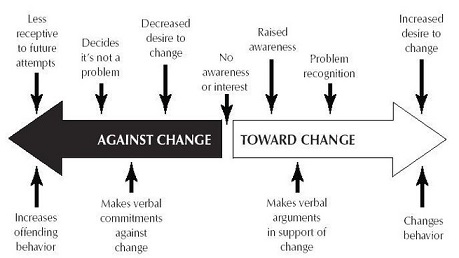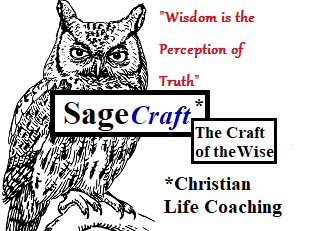The goal of all Life Coaching, every tool, every skill, every model, every process, and every framework is CHANGE. The Client wants (or SHOULD want) to change from what they have currently, to something else that they believe is more desirable. Behavior change is the most important tool for changing one’s results.
“All counseling [and SageCraft Christian Life Coaching] has to do with changes in beliefs, judgments, values, relationships, behavior, and other such moral elements of life. Sin in human life has led to distortions of life in each of these categories” – Jay Adams
From the Book: “Ready to Restore-a Layman’s Guide to Christian Counseling”
The dominant model for the human change process today is known as the “TRANSTHEORETICAL Model”. (Below) This model summarizes stages in the overall process of changing human behavior. It maps out the stages that nearly everyone goes through to resolve “ambivalence’ toward change of every kind. As a Life Coach, this model can be quite useful.
“The Word of God CHANGES people. It changes their thinking, changes their decisions, and changes their behavior“-Jay Adams
It is referred to as the “TRANS theoretical model” because the prefix “Trans“(From the Latin meaning “across, over, or beyond.”) indicates that it goes above and beyond any single school of thought in Psychology, and it crosses the boundaries of all theoretical models.

It doesn’t matter whether you favor Cognitive Behavioral Therapy, Psychodynamic, Rogerian Counseling, Operant Conditioning, Rational Emotive Behavior Therapy, etc. … or just plain ol’ commonsense CONVERSATIONAL CHANGE
SageCraft Christian Life-Coaching is also a “transtheoretical” process.-Rich Dallas Achology Certified Life Coach.
The model applies to any-and-all of them. It can be useful to you as a Life Coach. A person who is ambivalent about change may go through these stages quickly or slowly, but the idea is that they WILL go through, pretty much, ALL of them, no matter your school of thought. Just as in the example of the Kubler-Ross model of grief, the process is mapped out.
USEFUL LEARNING TOOL:
…DEVELOPED IN THE CONTEXT OF HELPING PROBLEM DRINKERS AND DRUG ABUSERS…IT HAS BROADER APPLICATIONS…LIKE LIFE COACHING.
This model was first developed in the context of clients who have substance abuse problems. It is readily adaptable to the Life Coaching process. Some of them were quite seriously addicted. It is widely taught by The US Government S.A.M.H.S.A. organization. Click on the image for their website. (Come back when you’re done!)
It was found that this model has much broader applications: The interesting thing is that this model applies to ANY kind of behavior change; Overeating, Smoking cessation, Life Coaching, Goal setting, Habit Change, even behaviors having to do with changing patterns of THOUGHT, and earning and saving money. The following article will provide you a more well-rounded introduction to this model:
This model has been discussed in several recent self-help books. It is described as a useful tool to guide your self-development. As a Life Coach, you might consider using it as an “orienting framework”. It helps you map out your client in the change process. You might consider printing the circular model out and committing it to memory.
Once that’s done, you can then ask questions of your client to determine what your client’s goals are, and where they are in the change process. Then you would use certain prescribed interventions for each stage, attempting to guide them through to the change process toward what they most desire. As a Life Coach, your task is then to help your client set a Well-Formed Outcome. That is a clear picture of what they want, as opposed to what they have.
Each of our brains is a “Cybernetic Goal-Striving Mechanism”. Once you’ve helped someone set A WELL-FORMED outcome, you’ve already started the change process – Rich Dallas – Achology Certified Life Coach


